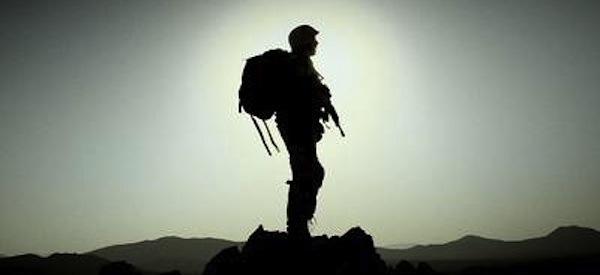
The Military Channel premiers a new series, Ultimate Warfare, on January 29, 2013. All images courtesy of Military Channel.
The new ten-part Military Channel series Ultimate Warfare premieres January 29 at 10:00 p.m. Eastern Time with the fascinating journey of the first American forces to enter Baghdad on April 5, 2003, and who, in cooperation with other units, were responsible for the fall of the Iraqi capital four days later. In 2003 the United States and the United Kingdom led a multinational coalition against the regime of Saddam Hussein in the Second Gulf War (OPERATION IRAQI FREEDOM). The short military action to some degree picked up where the First Gulf War (OPERATION DESERT STORM) left off twelve years prior. Unlike DESERT STORM, in which a US–UK led coalition forced Iraq out of neighboring Kuwait but left Hussein in power, in IRAQI FREEDOM American troops advanced to the outskirts of Baghdad, the Iraqi capital and center of the Iraqi dictator’s power.
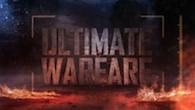 Ultimate Warfare looks to be a series devoted to pivotal battles of modern warfare from World War II to present day. The next two episodes after the January 29 premiere of "Baghdad: Thunder Runs" are "Kandahar: Against All Odds" and "Courage at Sea." (Only the first episode, "Baghdad: Thunder Runs," is covered in this review.) This series is "documented history," a style that relies on the modern technology that covers major events, such as war, as they are occurring. This gives audiences an intimate as-it-is-happening visual and auditory experience, though sophisticated audiences know even television-style clips of actual events can be subject to interpretation or manipulation.
Ultimate Warfare looks to be a series devoted to pivotal battles of modern warfare from World War II to present day. The next two episodes after the January 29 premiere of "Baghdad: Thunder Runs" are "Kandahar: Against All Odds" and "Courage at Sea." (Only the first episode, "Baghdad: Thunder Runs," is covered in this review.) This series is "documented history," a style that relies on the modern technology that covers major events, such as war, as they are occurring. This gives audiences an intimate as-it-is-happening visual and auditory experience, though sophisticated audiences know even television-style clips of actual events can be subject to interpretation or manipulation.
In "Baghdad: Thunder Runs" the Ultimate Warfare production team creates a very good representation of documented history. The clips are excellent and prolific, a testament to how well OPERATION IRAQI FREEDOM was covered by the military and the press—and even by amateurs using small video and digital cameras. The people who speak on camera, veterans of the campaign, are real. Graphics and special effects maintain the dramatic tension without overpowering the reality of the scenes.
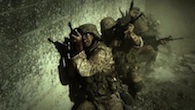 The story of this episode is a piece of history worth knowing in detail. When OPERATION IRAQI FREEDOM began, US and UK forces entered the country in armored columns supported by infantry. As coalition forces approached the capital city of Baghdad, brushing aside light resistance, airstrikes repeatedly hit the capital. For psychological as well as military reasons—Iraqi government propagandists insisted Saddam’s government was still in control—it was determined that ground units had to enter the capital.
The story of this episode is a piece of history worth knowing in detail. When OPERATION IRAQI FREEDOM began, US and UK forces entered the country in armored columns supported by infantry. As coalition forces approached the capital city of Baghdad, brushing aside light resistance, airstrikes repeatedly hit the capital. For psychological as well as military reasons—Iraqi government propagandists insisted Saddam’s government was still in control—it was determined that ground units had to enter the capital.
Task Force 1-64, code name "Rogue," was selected from an armored brigade for a "thunder run" mission—what at one time would have been called a mobile reconnaissance in force—into and through Baghdad. The term originated during the Vietnam War when tanks were sent out at night to keep supply routes clear, and it came to refer to "any rapid dash through hostile territory," as David Zucchino explained in Thunder Run: The Armored Strike to Capture Baghdad (Grove Press, 2004).
The program shows that by the 17th day of the Second Gulf War, "shock and awe" bombing of Iraq had produced no toppling of Hussein and his scattered forces. For the first time since World War II Americans would take an armored column into the capital of a hostile enemy.
Lieutenant Colonel Eric Schwartz appears on camera and tells firsthand much of the story of how the mission he was assigned to lead evolved quickly—and with little intelligence about what was in store for his tankers. This initial thunder run was an advance up the main road into Baghdad from U S positions south of the city, then west to the coalition-held international airport. From the early morning start of the mission it was obvious this was no walk in the park. Ad hoc groups of Iraqis with small arms and rocket grenade launchers were at every turn.
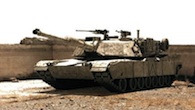 The graphic footage of the thunder run along with descriptions of the action from Schwartz and others in the column produces some strong impressions. First, the M1A1 Abrams tank is an awesome vehicle. Its maneuverability—despite the weight of uranium-enriched Chobham armor believed to give it the equivalent protection of 24 inches of armor plating—power and 120mm cannon, make this beast a superior weapon. Second, even tanks as well-protected as the Abrams are vulnerable in urban warfare. Fire came in from every direction including from above as the tanks passed along a multi-level superhighway. One of the tanks in this area was hit with a lucky shot and had to be abandoned, stripped of top-secret gear and destroyed. In a follow-up thunder run two days later Task Force China was ambushed here.
The graphic footage of the thunder run along with descriptions of the action from Schwartz and others in the column produces some strong impressions. First, the M1A1 Abrams tank is an awesome vehicle. Its maneuverability—despite the weight of uranium-enriched Chobham armor believed to give it the equivalent protection of 24 inches of armor plating—power and 120mm cannon, make this beast a superior weapon. Second, even tanks as well-protected as the Abrams are vulnerable in urban warfare. Fire came in from every direction including from above as the tanks passed along a multi-level superhighway. One of the tanks in this area was hit with a lucky shot and had to be abandoned, stripped of top-secret gear and destroyed. In a follow-up thunder run two days later Task Force China was ambushed here.
The Task Force Rogue battalion made it to the safety of the airport then returned to base with a much better idea of what was in store for troops entering the city. Still, the Iraqi government’s propaganda denied the enemy was at the gates. So Rogue returned on April 7 with a second battalion, "Tusker," to take key points and government buildings in the center of the city. The two columns encountered the same level of guerilla resistance as in the first run through the city but this time the tank battalions were coming to Baghdad to stay. Task Force China was following them to open a supply line back to base.
Rogue’s tanks entered the parade ground in central Baghdad and, with Fox News providing live coverage, blew apart a mounted statue of Saddam Hussein. The Iraqi government could no longer deny that American forces occupied their capital. Tusker went ahead to occupy the grounds of Saddam’s Republican Palace. This they did with ease. When searching the palace room by room later in the day, only a few squatters were found in the once-lavish seat of the dictatorship.
The tankers remained alert for signs of trouble throughout their first night in the capital. Tusker was hit by a counterattack in the early morning darkness. When the fire became too hot, air cover was called in, and A-10 Warthog fighter-bombers strafed and fired rockets to quell the uprising. Within two days Baghdad was secured to the point that joyful residents could pull down the huge standing statue of Saddam Hussein. The real Saddam had already fled the capital.
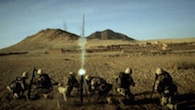 The eyewitness stories provided by the half-dozen veterans of Baghdad thunder runs who appear on camera are as insightful as any I’ve seen. Of course, their memories are very fresh; they speak with clarity and appropriate but understated emotion about the missions. Were the objectives met? How were the wounded treated? What were the hottest fights? One staggering problem that most of them dealt with was when to fire—civilians intermingled with militia and suicide bombers on the streets and in unmarked vehicles. Split-second decisions had to be made about where and who the enemy were.
The eyewitness stories provided by the half-dozen veterans of Baghdad thunder runs who appear on camera are as insightful as any I’ve seen. Of course, their memories are very fresh; they speak with clarity and appropriate but understated emotion about the missions. Were the objectives met? How were the wounded treated? What were the hottest fights? One staggering problem that most of them dealt with was when to fire—civilians intermingled with militia and suicide bombers on the streets and in unmarked vehicles. Split-second decisions had to be made about where and who the enemy were.
These accounts are so compelling that this brings me to my greatest criticism of the program. The narrator often engages in hyperbole. So many things are labeled as "dangerous," "desperate" and "devastating" that it’s a bit like the boy who cried wolf. The audience can see the well-crafted narrative play out; there’s no need to whip up dramatic tension with adjectives when the self-obvious is already in the material. On the other hand, the graphics are slick and yet subtle, mostly illustrating the weapons and equipment facts and not turning the scenes into comic book fantasy. The music and sound effects are appropriate. However, the strength of this program remains the exciting visual clips and the words of those who experienced the missions. No monster truck show could offer a better moment than an Abrams tank going airborne over a concrete barrier!
The next two episodes offer accounts of a battle in the war in Afghanistan and the World War II Battle of Leyte Gulf. Ultimate Warfare, light on politics and strategy and heavy on tactics and battle action, looks to be a credible television experience for the military history aficionado.
About the Author
Jay Wertz is the producer-director-writer of the award-winning 13-part documentary series Smithsonian’s Great Battles of the Civil War for The Learning Channel and Time-Life Video. He authored The Native American Experience and The Civil War Experience 1861-1865 and co-authored Smithsonian’s Great Battles and Battlefields of the Civil War with prominent historian Edwin C. Bearss. His most recent publications are War Stories D-Day: the Campaign Across France and War Stories: The Pacific, Vol. I, Pearl Harbor to Guadalcanal, published by World History Group Publications.




